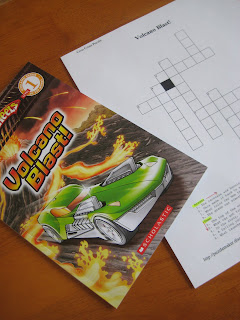I can’t believe that I’ve been blogging consistently since
April (thank you for tagging along, blog followers!) and that 2011 is nearly
over. This year was a phenomenal one. My son has advanced tremendously in
school, which is proof positive that a wonderful teacher and the right kind of
encouragement at home equal a more successful learning experience.
Before the year closes, I wanted to recap some of the
activities near and dear to my heart (and faves of my son) that may have gone
unnoticed.
#11
Get outside and search high and low for the wonders that nature
has waiting for you! This free download has been one of my most popular
printables.
#10
Teach kids about where U.S. currency is minted; then grab
some coins and have them graph where the coins are from. Will there be more
minted in Philadelphia or Denver?
#9
Art from other cultures can be so hard to relate to. This
printable book draws comparisons between the masks of Africa and many western
activities and traditions. Art projects don’t always hold my son’s attention
for long periods; however, that wasn’t the case when he made a milk jug ‘African’
mask!
#8
Read about the planets and then practice right and left with
a winding word puzzle. As kids follow the directions, moving around the word
grid, the words they land on form clues. The answer to each clue is one of the planets in
our solar system.
#7
Make several paper airplanes and then see which flies the
farthest. This activity is a fun way to practice measuring and ordering the
planes to see which one got first, second, third, etc. place.
#6
Grab a can of mixed nuts; they are an amazing math
manipulative – not to mention they taste so darn good too! Kids sort, tally and
skip count each variety, then rank them yummiest to yuckiest after doing a
taste test.
#5
Make a stunning art project by alternating rectangles made
from strips of colored cardstock with yarn-block stamped rectangles. This Kente
cloth-inspired paper project provides the perfect opportunity to practice AB, AAB, ABC, and ABB patterns!
#4
My son LOVES this. It’s quite possibly his favorite math
activity. Doing a worksheet of math problems is a bore. Make the answers a code
and WHAM!, your child feels like a secret agent on a math mission.
#3
A DIY castanet-style snapping turtle is perfect to click
words’ syllables. We made a game of it! Kids draw a card, click the syllables with
“Snappy,” and move their game piece the number of syllables in the word. The player
to get Snappy back home to the lake first wins.
#2
Got LEGOs? Then simply print these downloads and get ready
for some fun greater-than/less-than practice. Kids put the blocks in two piles,
determine which is greater than the other, then use those to build with.
#1
Months after making his organs shirt, my son can still identify many of the organs he
painted and what they do!
My son is growing into a very curious boy. I hope to
continue to encourage his inquisitiveness in 2012. Stay tuned for more fun activities
that sneak in science, history, math, art, and language arts in the new year!











































